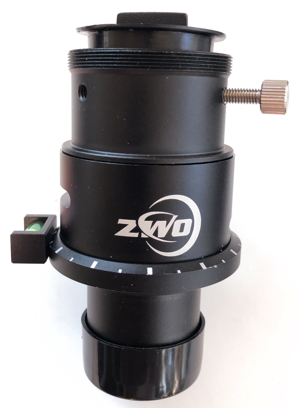Review - ZWO Atmospheric Dispersion Corrector
Posted: 15 August 2019

1.25" Atmospheric Dispersion Corrector
ZWO
$128
A friend mentioned the ZWO Atmospheric Dispersion Corrector (ADC) to me as a way to reduce the atmospheric diffraction affects seen when viewing and imaging planets that appear low in the sky. After thinking about it awhile I decided to order one from Oceanside Photo and Telescope and give it a try. The ZWO ADC arrived a few days later.
The ADC removes the red and blue color fringing diffraction effects using two opposing prisms that are adjusted with levers on the side of the tube. The ADC fits into 1.25" eyepiece holders and can accept 1.25" eyepieces for visual use. For astrophotography you can do eyepiece projection, afocal, or prime focus imaging.
The ZWO ADC comes in a small box.

There were no usage instructions included. While the basic operation is obvious, the purpose of the attached "bubble level" was unclear. I checked the ZWO web site and I found a short manual available. The manual describes how to align the ADC with your local horizon (as viewed through the telescope) using the bubble level and how to reduce color fringing using cameras (color and mono) with the FireCapture or SharpCap applications. Surprisingly there were no visual use instructions in the manual, but depending on the magnification used and object altitude above the horizon you should be able to see the color fringing in an eyepiece, especially at higher magnifications.


There are three setscrew holes on the eyepiece end. This allows you to position the two screws for different equipment orientations.
The white nylon screw, called a "center marker" in the manual, has a confusing use. The manual implies that it is necessary to center the knob in the middle of the lever slots. But the ring with the knob and the bubble level is movable. Since this seems to be a required "fixed" position, why is this ring movable? If the user moves it, as I did, it would seem to make the "zero position" of the prisms less precise. I sent an inquiry to ZWO; they confirmed that the manual is correct and that the ring/bubble are meant to be movable so that the bubble can be aligned to the horizon. However, what they don't explain is that in some positions of the ring you will not be able to line up the prism levers for the zero correction position due to the limited travel in the slots. Just something to be aware of.
Visual Use
I initially checked out the ADC on the planets of Jupiter and Saturn, which were 33° and 20° above the horizon in my sky. This allowed me to learn how to best operate the ADC to reduce color fringing. I tested the ADC with and without using a star diagonal. Here are some photographs showing different setups:
15mm eyepiece

Star Diagonal, 15mm eyepiece

Star Diagonal, 15mm eyepiece + 2X Powermate

With the bubble level on top I found it easy to align the ADC to the horizon with or without the diagonal. With a 15mm eyepiece (163X) color fringing was minimal but still visible. At 325X color fringing was more readily seen. Moving the prism adjustment levers was simple. You start with the levers together at the 3 o'clock position and then spread them apart equally. I moved them so that color fringing was made worse and then reduced the amount of blue and red fringing by moving the levers closer together until the color fringing was gone. The view of both Jupiter and Saturn at both magnifications was crisper with correction than without. With Saturn's low altitude at the time of the initial tests Cassini Division was not visible without correction but popped into view once the correction was applied. That was a dramatic indication of the value of using the ZWO ADC. Focusing was not a problem with the 12" LX600 telescope and the accessories I used. I did see some image shifting as the prisms in the ADC were moved using the levers but it was minor for normal corrections.
Go to the ADC Astrophotography and Summary page.
Comments are welcome using Email. If you are on Twitter you can use the button below to tweet this review to your followers. Thanks.
Cassiopeia Observatory Home Page
Copyright ©2019 Michael L. Weasner / mweasner@me.com
URL = http://www.weasner.com/co/Reviews/2019/ZWO_ADC/index.html

